Breeding Orpington chickens

Orpington chickens are described as "Large and stately in appearance, with long round deep bodies and very full breast and back development. The abundance of hackle and saddle feathers on the Orpington male gives him the appearance of having a short back, whereas it is both broad and long like that in the female Orpington."
Selecting the best of your stock to breed from is a must and you should familiarise yourself with the breed standards or the standards of perfection. You are unlikely to be able to breed show stock from hatchery birds so sourcing the best of their type to begin with will pay dividend in the long run.
Selecting Orpingtons for breeding:
When it comes to breeding Orpingtons you should try to breed for type and feathering before colouring. A good example of an Orpington should not depend on loose feathering for shape.
Below: The Buff Orpington is the most common colour and the easiest to find.
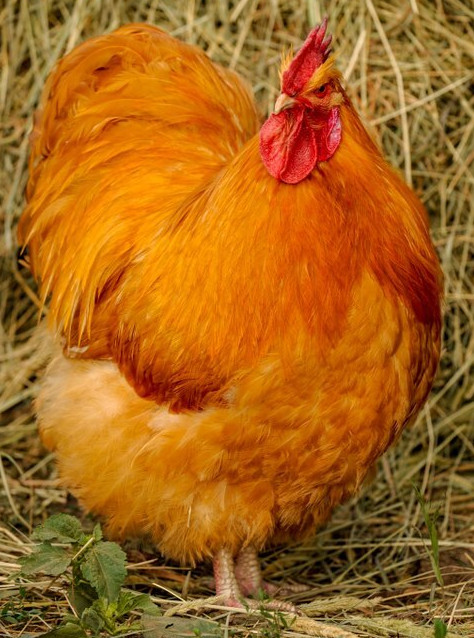
An even feather colour in types like the Buff can be easily selected for after the size and shape has been perfected.
Below: When selecting white Orpingtons, avoid any hint of yellow or brassiness in the feathers.
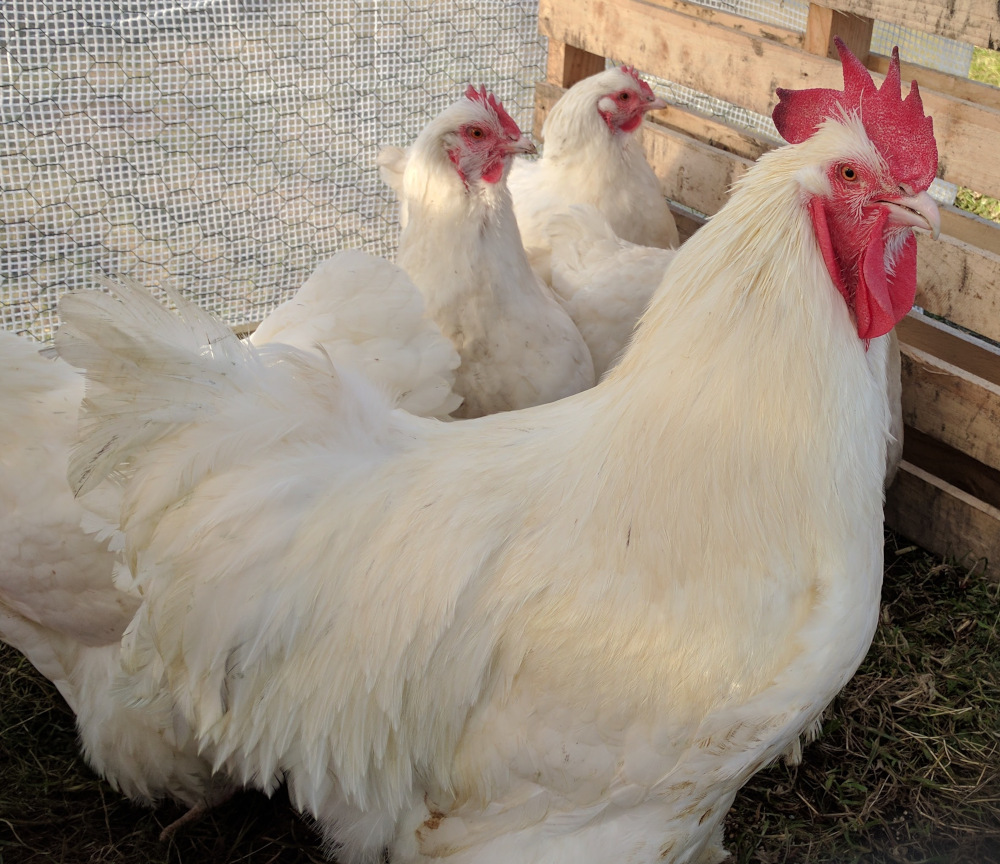
Never choose chickens that have been sick in the last 12 months for breeding or had any sort of genetic malformation like splayed legs. Breeding stock should be active and mobile and display all the behaviours of a healthy chicken.
Avoid choosing Orpingtons that are bad tempered, the calm disposition is a character of the breed.
Are Orpingtons naturally broody and do they make good mothers?
A good percentage of my Orpington flock go broody every year.
This year I had 6 broody from a flock of nearly 40 birds. Orpingtons are more likely to go broody in their second year and it is quite common for one hen to raise two clutches a year.
Below: A trio of Partridge Orpingtons with some chicks.
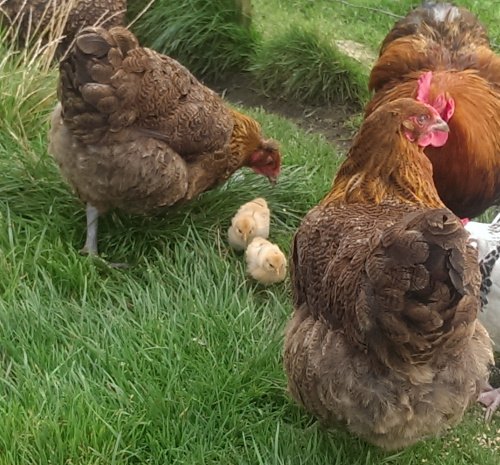
My Orpingtons have always made good mothers although one or two young birds have had false starts in their first year.
The other advantage is that because of their great size, they can cover 16 eggs with ease and do not struggle to raise large litters.
Are Orpingtons easy to breed?
Orpington chickens are relatively easy to breed but they take 30 weeks to mature so it is not a quick process.The colours generally breed true with the exception of the blue and the Jubilee Orpington often has a better pattern after a moult.
Orpingtons do not need to be double mated which greatly reduced the number of breeding pens required.
Below: Orpingtons are often described as square, this simply means if you were to draw a box around the bird, it should touch all the corners and fill the box as much as possible.
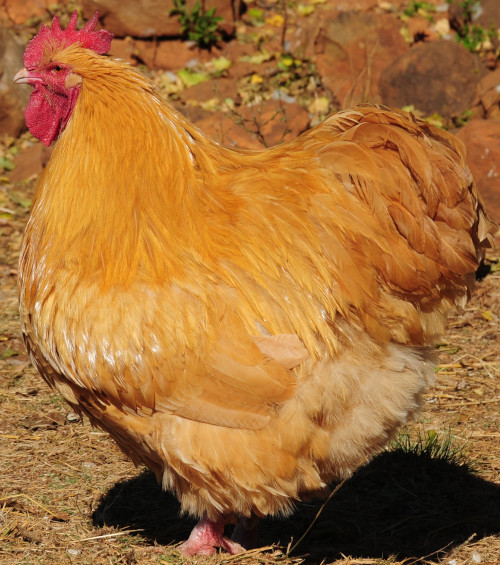
Not all colours and feather patterns are recognised by all countries poultry clubs so if you plan to exhibit Orpingtons you should check which are allowed in your standards.
Breeding hints for Orpington chickens:
- Fertility peaks in Spring and tails off into summer and this is the best time to hatch.
- Some exhibition males require their feathers trimming in order to allow successful mating.
- Fertility may suffer if the males have more than 4 hens to cover.
- They need slightly larger and more airy nest boxes.
- Orpingtons for breeding really need to be free ranged or have access to pasture.
- Choose birds that are symmetrical down the centre line and have straight tails.
- Choose chickens that are more than 1 year old as breeding stock.
- Breed for shape and size first, then colour second.
- Do not choose Orpingtons for breeding that drag their feathers on the ground.
How do you breed blue Orpingtons?
The breeding of blue feathered chickens of all types is a wasteful process as the chicks can be either blue, black or splash.
Breeding colour table for blue Orpingtons:
- Blue X Blue = 50% Blue, 25% Black, 25% Splash.
- Blue X Black = 50% Blue, 50% Black.
- Blue X Splash = 50% Blue, 50% Splash.
- Black X Black = 100% Black.
- Splash X Splash = 100% Splash.
- Splash X Black = 100% Blue.
Blue should not be mixed with Lavender.
Below: Orpington eggs should be brown.
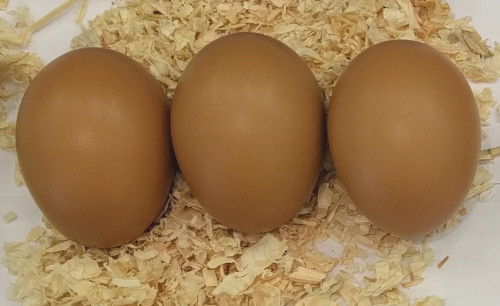
Egg colour is one of the hardest qualities to preserve when breeding and seems to follow the female line more than the male.
Breeding Lavender Orpingtons:
Lavender, sometimes called self-blue, is a different gene from the standard blue and is recessive. Lavender birds should be kept separately from the Blue / Black / Splash breeding groups as the result is a mess.
Because Lavender is recessive to get the colour required both copies of the gene to be present. A lavender Orpington with only one copy of the gene will be black.
Below: Avoid obvious faults like the uneven comb in this cockerel.

The first generation that carries the gen is called split as it is split 50/50 black and Lavender.
To get Lavender chicks you will need to inbreed the offspring with each other as they will only be carriers.
Lavender Orpington colour table:
- Lavender X Lavender = 100% Lavender.
- Black X Lavender = 100% split.
- Split X Lavender = 50% Split / 50% Lavender.
- Black X Split = 50% Split / 50% Black.
- Split X Split = 50% Split / 25% Lavender / 25% Black.
Breeding Jubilee Orpingtons:
The jubilee colour is one of the hardest to produce properly and it changes from year to year as the birds moult.
The basic shape and selection criteria are the same for the Jubilee feather pattern as other Orpingtons.
Below: A young jubilee Orpington hen. Note the light colour on the feather before her first moult.
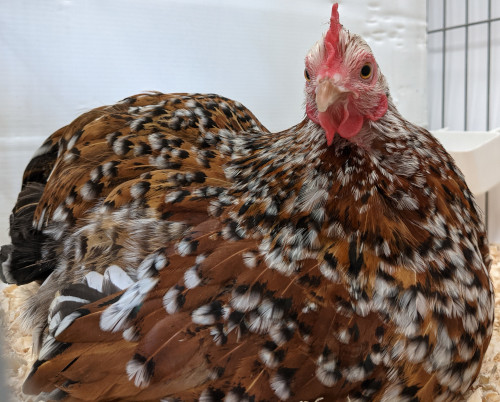
Below: A darker bird after her first moult. The feathers are a deeper colour and the white tips are smaller.
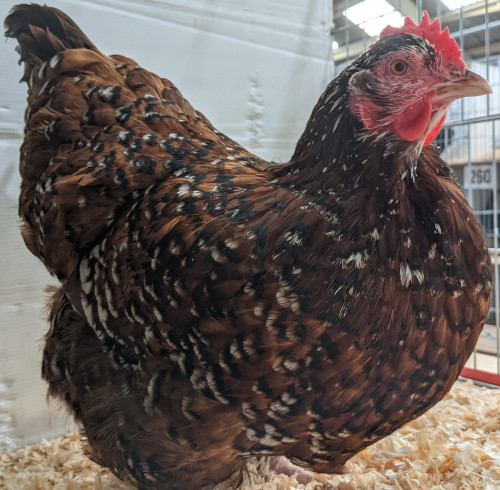
Breeding Colombian or Ermine Orpingtons:
The Colombian, sometimes called the Ermine feather pattern has a ruff of black feathers around the neck and a black tip tho the tail and both wing tips. The black neck and wing feathers are edged in a thin white line which served to provide definition to the feathers.
The ideal Colombian is a deep and even ruff and large clearly defined wing tips and tail. Evenness and definition are the goals here.
The points of utility which make a breed like the Orpington of most value to keepers and small breeders are egg production, good size, hardiness, being solid sitters and mothers, and a good table bird.
